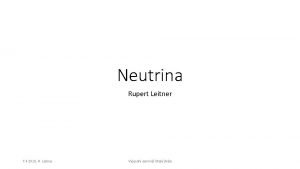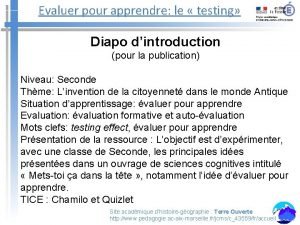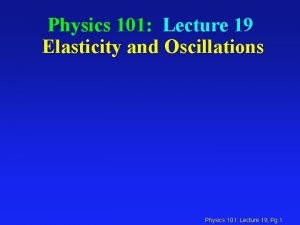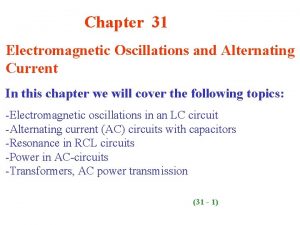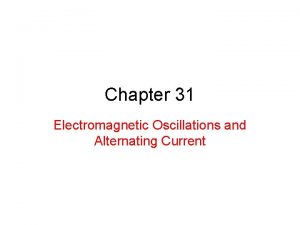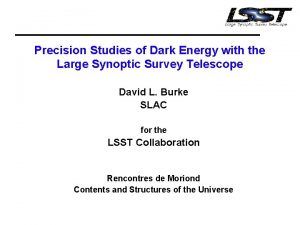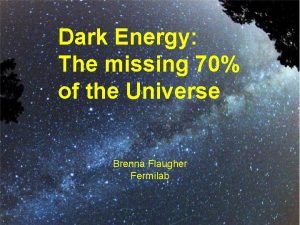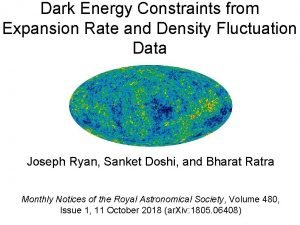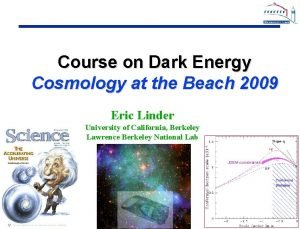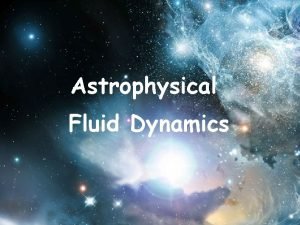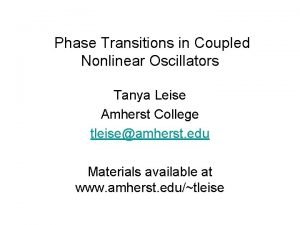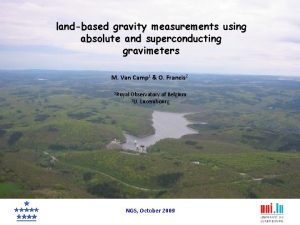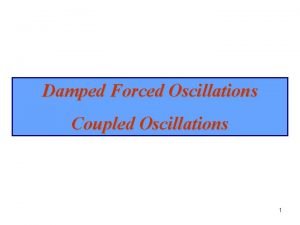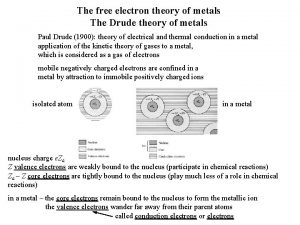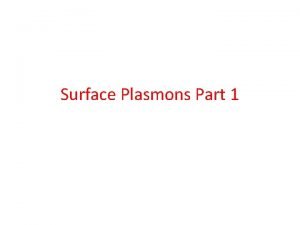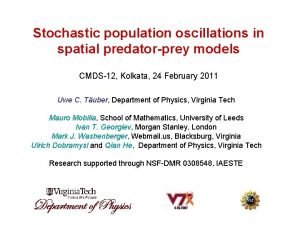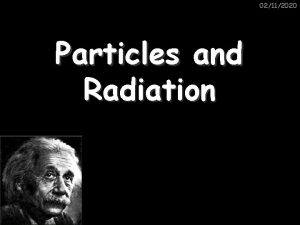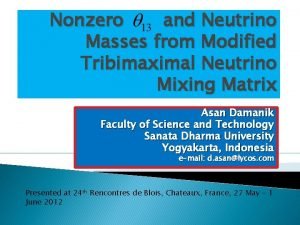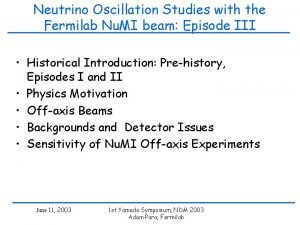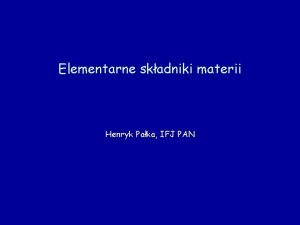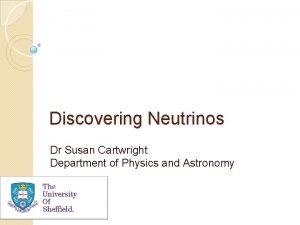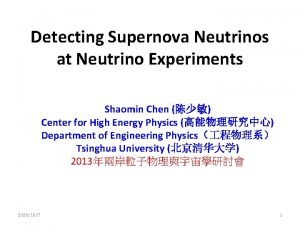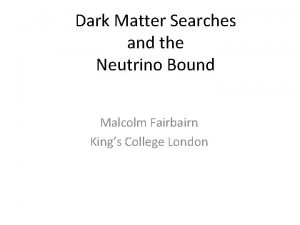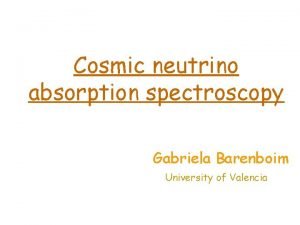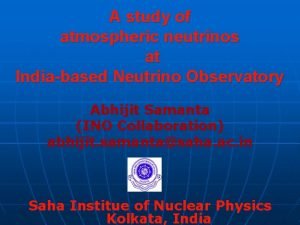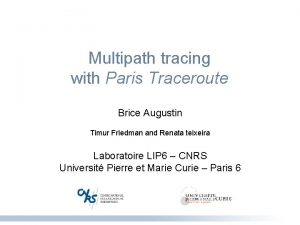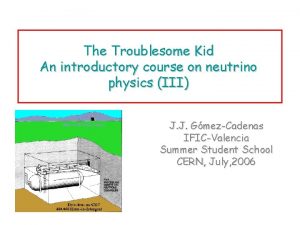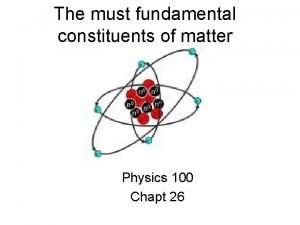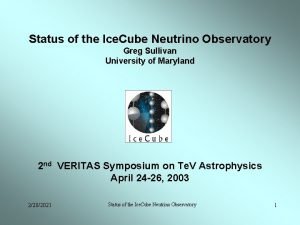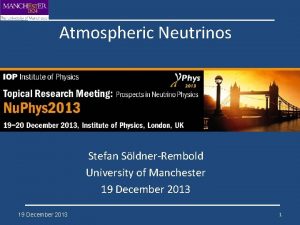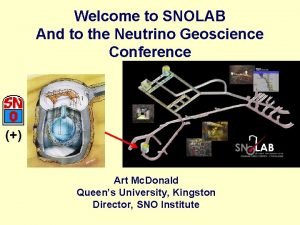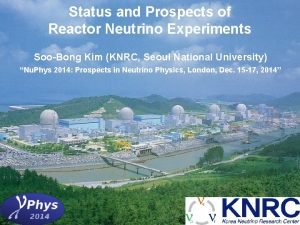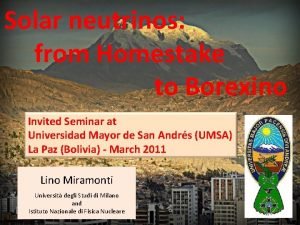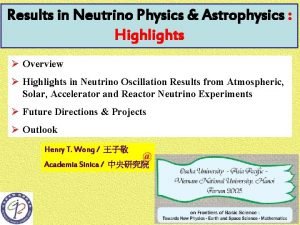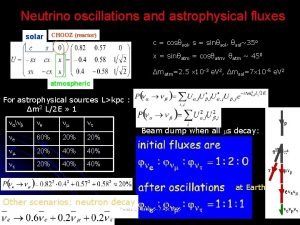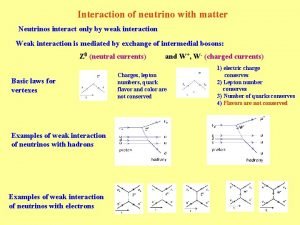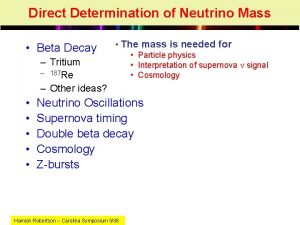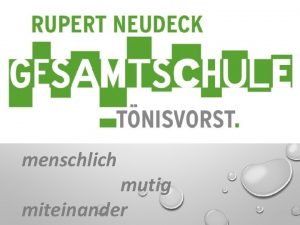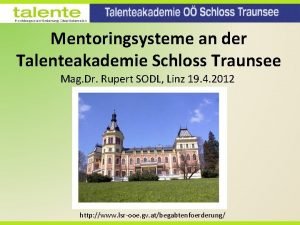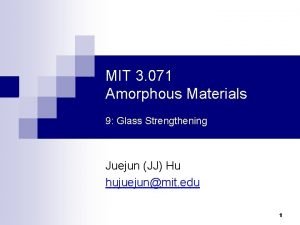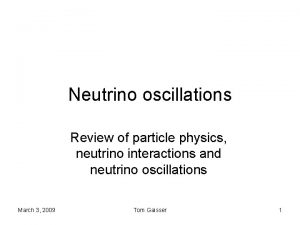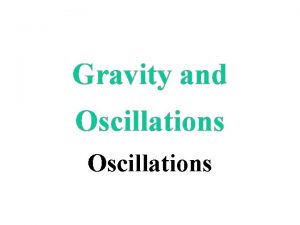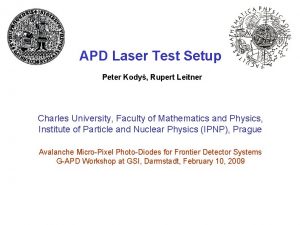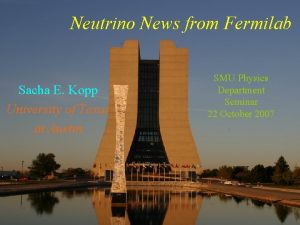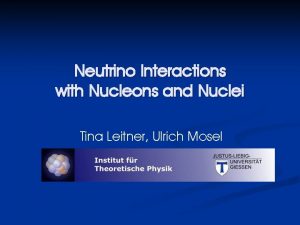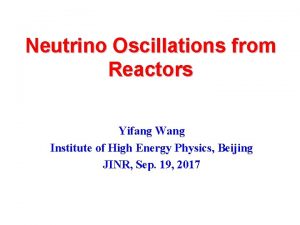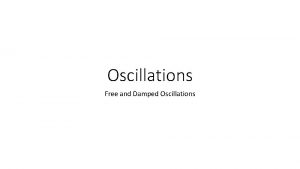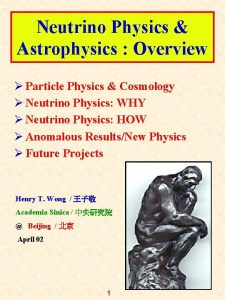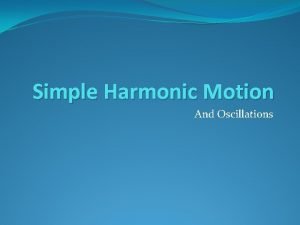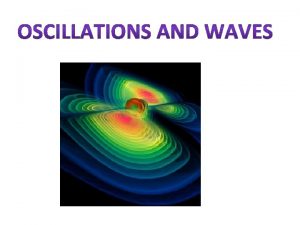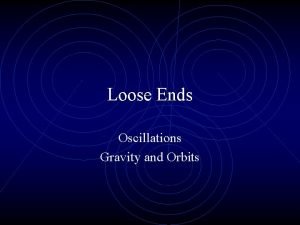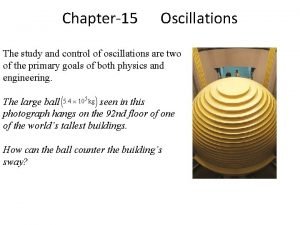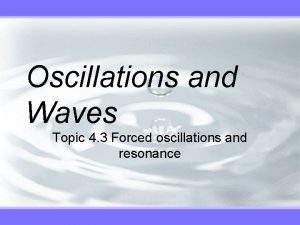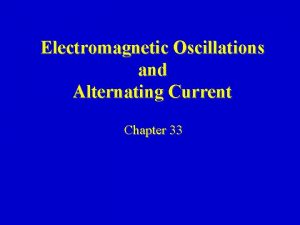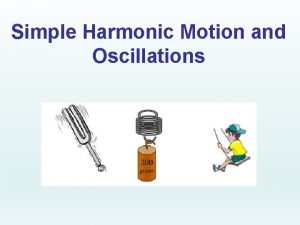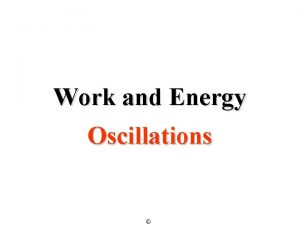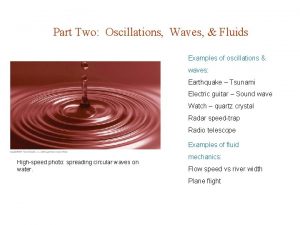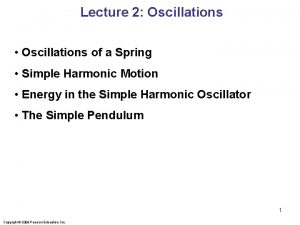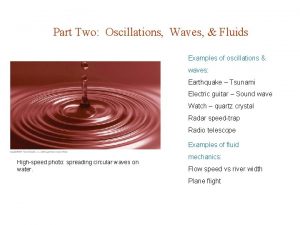Neutrino Oscillations Rupert Leitner Institute of Particle and










![P 500 km/Ge. V 21. 2. 2014 L/E [km/Ge. V] Interuniversity Institute for High P 500 km/Ge. V 21. 2. 2014 L/E [km/Ge. V] Interuniversity Institute for High](https://slidetodoc.com/presentation_image_h/26f9b5cf38bdb679d19325595df9d12a/image-11.jpg)







































- Slides: 50

Neutrino Oscillations Rupert Leitner Institute of Particle and Nuclear Physics Faculty of Mathematics and Physics, Charles University, Prague 21. 2. 2014 Interuniversity Institute for High Energies (ULB-VUB), Brussels

Neutrino oscillations • Neutrino oscillations are firmly established by many experiments using neutrinos from the Sun, cosmic rays, accelerators and nuclear reactors • Nowadays neutrino oscillation experiments are producing very precise results of oscillation parameters with the aim to reveal possible violation of combined CP parity 21. 2. 2014 Interuniversity Institute for High Energies (ULB-VUB), Brussels

Neutrino flavor eigenstates produced in weak interactions are different from mass eigenstates off-diagonal Unitary mixing matrix: 21. 2. 2014 Interuniversity Institute for High Energies (ULB-VUB), Brussels

Let neutrino of given flavor f is produced At a distance L: The phase factors are different and other flavors will apear With the amplitudes 21. 2. 2014 Interuniversity Institute for High Energies (ULB-VUB), Brussels

Consequences of the CPT invariance 21. 2. 2014 Interuniversity Institute for High Energies (ULB-VUB), Brussels

2 x 2 (flavor x mass) case Disappearance Appearance 21. 2. 2014 Interuniversity Institute for High Energies (ULB-VUB), Brussels

Amplitude of oscillations = sin²(2θ), oscillation length is inversely proportional to Δm² 21. 2. 2014 Interuniversity Institute for High Energies (ULB-VUB), Brussels

Neutrino mixing - 3 flavors x 3 mass case: Canonical representation of Pontecorvo-Magi-Nakagawa-Sakata mixing matrix is done by ordered product of 12, 13 and 23 rotations, one CP phase δ connected to the smallest mixing angle θ 13 and two Majorana phases α 1, 2. Majorana phases α are irrelevant for oscillations. 21. 2. 2014 Interuniversity Institute for High Energies (ULB-VUB), Brussels

Atmospheric, Accelerator, Reactor Sun, Reactor 21. 2. 2014 Interuniversity Institute for High Energies (ULB-VUB), Brussels

First oscillation result from Super Kamiokande experiment Observed deficit of muon neutrinos not compensated by the electron neutrino appearance. (disappearance of muon neutrinos to tau neutrinos) 21. 2. 2014 Interuniversity Institute for High Energies (ULB-VUB), Brussels
![P 500 kmGe V 21 2 2014 LE kmGe V Interuniversity Institute for High P 500 km/Ge. V 21. 2. 2014 L/E [km/Ge. V] Interuniversity Institute for High](https://slidetodoc.com/presentation_image_h/26f9b5cf38bdb679d19325595df9d12a/image-11.jpg)
P 500 km/Ge. V 21. 2. 2014 L/E [km/Ge. V] Interuniversity Institute for High Energies (ULB-VUB), Brussels

Results on Δm 232 and θ 23 SK = Super. Kamiokande atmospheric neutrinos T 2 K = accelerator neutrinos from JPARC measured by Super. Kamiokande (295 km) MINOS = accelerator neutrinos from Fermilab mesured by MINOS (735 km) 21. 2. 2014 Interuniversity Institute for High Energies (ULB-VUB), Brussels

Off axis neutrino beams (T 2 K and NOv. A) θ θ 21. 2. 2014 Interuniversity Institute for High Energies (ULB-VUB), Brussels E(θ)=E(θ)

Solar neutrinos The deficit of Solar neutrinos measured since late sixties by R. Davis in Cl-Ar experiment proposed by B. Pontecorvo 21. 2. 2014 Interuniversity Institute for High Energies (ULB-VUB), Brussels

Neutrino oscillations in matter are modified due to coherent forward scattering Neutrinos of all flavors ve, f Only electron neutrinos e ve Z e, p, n anti ve e W W e ve e anti ve So called mass effect can distinguish Δm 2>0. vs. Δm 2<0 !! 21. 2. 2014 Interuniversity Institute for High Energies (ULB-VUB), Brussels

0. 1 Me. V νe vmu+vtau 21. 2. 2014 Interuniversity Institute for High Energies (ULB-VUB), Brussels 10 Me. V

Solar puzzle solved by SNO experiment (Sudbury Neutrino Observatory) CC n e + d p + e− - Q = 1. 445 Me. V - good measurement of ne energy spectrum - some directional info (1 – 1/3 cosq) - ne only NC n x + d p + n +n x about 30 events per day. - Q = 2. 22 Me. V - measures total 8 B n flux from the Sun - equal cross section for all n types ES n x + e− - low statistics - mainly sensitive to ne, some n and n Institute for High Energies -21. 2. 2014 strong directional sensitivity Interuniversity (ULB-VUB), Brussels about 3 events per day.

1/3 of neutrinos are electron, 2/3 are tau and muon neutrinos 21. 2. 2014 The total flux agrees with SSM prediction Interuniversity Institute for High Energies (ULB-VUB), Brussels (Standard Solar Model prediction)

Nuclear reactors are powerful sources of electron antineutrinos Fission products are neutron rich. The valley of stability is reached by series of beta- decays. In average app. 6 electron antineutrinos are produced per fission. App 200 Me. V is released per fission 21. 2. 2014 Interuniversity Institute for High Energies (ULB-VUB), Brussels

21. 2. 2014 Interuniversity Institute for High Energies (ULB-VUB), Brussels

Results on Δm 221 and θ 12 21. 2. 2014 Interuniversity Institute for High Energies (ULB-VUB), Brussels

3 flavors x 3 mass case before 2011 m 3 Normal hierarchy m 2 m 1 Inverted hierarchy m 3 21. 2. 2014 Interuniversity Institute for High Energies (ULB-VUB), Brussels

Measurement of θ 13 It measures admixture of electron neutrinos in the mass eigen state m 3. Non zero value of theta 13 implies that oscillations of electron neutrinos governed by large mass difference must exist. It is necessary condition for possible CP violation in neutrino oscillations requires 0. 5 km/Me. V 21. 2. 2014 Interuniversity Institute for High Energies (ULB-VUB), Brussels

Mixing angle θ 13 sin²(θ 13) is the fraction of electron neutrino in mass eigenstate m 3 Two ways to measure θ 13 -To measure electron (anti)neutrino disappearance (Daya Bay, RENO, Double Chooz) -To measure electron (anti)neutrino -appearance in muon (anti)neutrino beam (T 2 K, MINOS) Measurements has to be done at small values of L/E~0. 5 km/Me. V = 500 km/Ge. V: 21. 2. 2014 Interuniversity Institute for High Energies (ULB-VUB), Brussels

21. 2. 2014 Interuniversity Institute for High Energies (ULB-VUB), Brussels

21. 2. 2014 Interuniversity Institute for High Energies (ULB-VUB), Brussels

Expected amplitude of oscillations is few % - High reactor power and detector mass is needed to collect enough data - Far/Near detectors configuration and large overburden significantly reduce systematic uncertainties and backgrounds 21. 2. 2014 Interuniversity Institute for High Energies (ULB-VUB), Brussels

Detection of antineutrinos: Inverse Beta Decay (IBD) Only antineutrinos with energies larger than 1. 8 Me. V interact. Detected energy spectrum is the product of reactor neutrino Flux and IBD cross section and it reaches the maximum around 4 Me. V the first oscillation minimum is at 0. 5 km/Me. V 2 km for 4 Me. V 21. 2. 2014 Interuniversity Institute for High Energies (ULB-VUB), Brussels

Detection of antineutrinos via Inverse Beta Decay (IBD) is performed by the coincidence of prompt signal from positron and delayed signal of neutron capture on Gd. 21. 2. 2014 Interuniversity Institute for High Energies (ULB-VUB), Brussels

Neutron capture on Gadollinium 21. 2. 2014 Interuniversity Institute for High Energies (ULB-VUB), Brussels

Ammount of Gd is monitored by measurement of the time of neutron capture on Gd Very simplified estimation using Maxwell Boltzmann distribution of neutron velocities, app. cross section and Gd concentration gives: 21. 2. 2014 Interuniversity Institute for High Energies (ULB-VUB), Brussels

Anti-neutrino detectors v The Daya Bay anti-neutrino detectors (ADs) are “threezone” cylindrical modules. v LS=LAB+PPO(3 g/l)+MSB(15 mg/l), Gd-LS=LS+0. 103% Gd Calibration system Stainless Steel Vessel (SSV) Ø Zones are separated by acrylic vessels: Zone Inner acrylic vessel Outer acrylic vessel Stainless steel vessel Mass Liquid Purpose 20 t Gd-doped liquid scintillator Antineutrino target Liquid scintillator Gamma catcher (from target zone) 20 t 40 t Mineral Oil 192 PMTs Mineral oil Liquid Scint. 20 -t Gd-LS 5 m Radiation shielding Ø Top and bottom reflectors are used to increase light yield Ø Energy resolution: s. E/E = 7. 5%/√E+0. 9% 21. 2. 2014 Interuniversity Institute for High Energies (ULB-VUB), Brussels 5 m

Detector calibration R=1. 775 m R=0 R=1. 35 m Ø Three sources + LED in each calibration unit, on a turn-table: o 68 Ge (1. 02 Me. V) o 60 Co (2. 5 Me. V) o 241 Am-13 C o LED (8 Me. V) Energy calibration (linearity, detector response… etc) Timing, gain and relative QE Ø Can also use spallation neutrons (uniformity, stability, calibration, … etc). 21. 2. 2014 Automated Calibration Units (Daya Bay) Three calibration units per detector that deploy sources along z-axis Interuniversity Institute for High Energies (ULB-VUB), Brussels

• Outer layer of water Čerenkov detector (on sides and bottom) is 1 m thick, inner layer >1. 5 m. Water extends 2. 5 m above ADs • • 288 8” PMTs in each near hall 384 8” PMTs in Far Hall • 4 -layer RPC modules above pool • • 54 modules in each near hall 81 modules in Far Hall 21. 2. 2014 Interuniversity Institute for High Energies (ULB-VUB), Brussels

Assembly of Anti-neutrino detectors ADs are assembled in clean-room Stainless Steel Vessel (SSV) in assembly pit Install top reflector Close SSV lid Install lower reflector Install PMT ladders 21. 2. 2014 Install Acrylic Vessels Interuniversity Institute for High Energies (ULB-VUB), Brussels Install calibration units

Near Hall (EH 1) Installation Fill pool with purified water (~1 wk) Install filled AD 1 and AD 2 in pool Data taking started on 15 Aug 2011 21. 2. 2014 Roll RPC over cover Interuniversity Institute for High Energies (ULB-VUB), Brussels Place cover pool

Inverse Beta Decay Events Selection No signal > 0. 7 Me. V Prompt-delayed coincidence: – Prompt positron: 0. 7 Me. V < Ep < 12 Me. V Delayed neutron: 6. 0 Me. V < Ed < 12 Me. V – Capture Time: 1 μs < Δt< 200 μs Multiplicity: – No signal 200 μs around IBD Muon Veto: Pool muon (muon detected in water pool): veto following 0. 6 ms Muon signal (> 20 Me. V) detected in AD: veto following 1 ms High energy muon signal (AD shower muon >2. 5 Ge. V): veto following 1 s that is >5 T 1/2 of 9 Li / 8 He isotopes 21. 2. 2014 Interuniversity Institute for High Energies (ULB-VUB), Brussels

Capture on H 21. 2. 2014 Interuniversity Institute for High Energies (ULB-VUB), Brussels IBD candidates capture on Gd

Daily IBD rates are strongly correlated with reactor flux 21. 2. 2014 Interuniversity Institute for High Energies (ULB-VUB), Brussels

Backgrounds -Accidental coincidencies of neutrons produced by cosmic muons and natural radioactivity Fast neutrons Recoiled protons mimic the prompt signal 9 Li and 8 He isotopes Beta decays with neutron emission 21. 2. 2014 Interuniversity Institute for High Energies (ULB-VUB), Brussels

Background These isotopes are products of photonuclear interactions of cosmic muons on C nuclei 21. 2. 2014 Interuniversity Institute for High Energies (ULB-VUB), Brussels

Latest Daya Bay results reported at Nu. Fact 2013 conference August 2013 21. 2. 2014 Interuniversity Institute for High Energies (ULB-VUB), Brussels

Measured spectra and the oscillation curve 21. 2. 2014 Interuniversity Institute for High Energies (ULB-VUB), Brussels

21. 2. 2014 Interuniversity Institute for High Energies (ULB-VUB), Brussels

CP and T violation in lepton sector can be investigated with neutrino oscillations CPT: T = = CPT CP CP violation: CP T violation: T 21. 2. 2014 Interuniversity Institute for High Energies (ULB-VUB), Brussels -

< 3% T 2 K NOv. A 21. 2. 2014 Interuniversity Institute for High Energies (ULB-VUB), Brussels Future LBNE, LBNO experiments

NOv. A experiment Recently announced the first event NOv. A performance 21. 2. 2014 Interuniversity Institute for High Energies (ULB-VUB), Brussels

New T 2 K electron neutrino appearance result PRL 112, 061802 (2014) Uncertainties are still large, nevertheless certain regions of CP violating phase are excluded at 90% CL (see T 2 K paper). Normal hierarchy m 3>m 1, 2 The numu nue appearance probability is also a function of CP violating phase δ New Daya Bay result PRL 112, 061801 (2014) Values for normal and inverted hierarchy are shifted Inverted hierarchy m 3<m 1, 2 21. 2. 2014 Interuniversity Institute for High Energies (ULB-VUB), Brussels

SUMMARY -The value of the mixing angle θ 13 has been measured in reactor and accelerator experiments. The most precise measurement was performed by the Daya Bay experiment in configuration with 6 detectors: sin 22θ 13 = 0. 090 +0. 008 -0. 009 - The second oscillation parameter – the value of the mass square difference |Δm 2 ee| = ( 2. 59 + 0. 19 - 0. 20 ) 10 -3 e. V 2 has been measured for the first time with electron neutrinos -Since Oct 2012 the Daya Bay is taking data with 8 detectors. The precision of both results will eventually improve to few per cent. -High statistics of the data will allow for further interesting analyses. -Relatively large value of θ 13 opens the possibility to check the CP invariance in neutrino oscillation experiments. -Combination of T 2 K results on electron neutrino appearance and reactor data are sensitive to CP violating phase δ. 21. 2. 2014 Interuniversity Institute for High Energies (ULB-VUB), Brussels

There are still many open questions in neutrino physics - What is the value of CP violating phase δ? Searches for CP violation. (oscillation experiments) - Is m 3 heaviest or lightest of neutrino mass eigen states (normal or inverted hierarchy) ? (oscillation experiments) - What are absolute values of neutrino masses? (direct measurements of neutrino masses, KATRIN experiment) - Are neutrinos Majorana particles? (various neutrino-less double beta decay experiments) And many more, e. g. : are there more than 3 neutrinos, sterile? , what is the origin of neutrino masses? , neutrinos from Supernovae, … and many more Thank you very much for your attention 21. 2. 2014 Interuniversity Institute for High Energies (ULB-VUB), Brussels
 Rupert leitner
Rupert leitner Carl leitner
Carl leitner Chamilo st louis
Chamilo st louis Elasticity and oscillations
Elasticity and oscillations Electromagnetic oscillations and alternating current
Electromagnetic oscillations and alternating current Electromagnetic oscillation pdf
Electromagnetic oscillation pdf Baryon acoustic oscillations
Baryon acoustic oscillations Joint play grades
Joint play grades The universe faster than should be
The universe faster than should be Baryon acoustic oscillations
Baryon acoustic oscillations Baryon acoustic oscillations
Baryon acoustic oscillations Baryonic acoustic oscillations
Baryonic acoustic oscillations Coupled oscillations
Coupled oscillations Slow oscillations
Slow oscillations Coupled oscillations
Coupled oscillations Plasma oscillations
Plasma oscillations Plasma oscillations
Plasma oscillations Oscillations
Oscillations Dotterkärna
Dotterkärna Leptons
Leptons Emission spectrum of sodium
Emission spectrum of sodium Neutrino
Neutrino Neutrino
Neutrino Lekka cząstka elementarna mion elektron lub neutrino
Lekka cząstka elementarna mion elektron lub neutrino Who discovered neutrino
Who discovered neutrino Neutrino
Neutrino Neutrino
Neutrino Gabriela barenboim
Gabriela barenboim Neutrino
Neutrino Paris traceroute
Paris traceroute Neutrino
Neutrino Neutrino symbol
Neutrino symbol Ice cube para status
Ice cube para status Neutrino
Neutrino Solar neutrino
Solar neutrino Neutrino
Neutrino Solar neutrino
Solar neutrino Solar neutrino
Solar neutrino Neutrino mass
Neutrino mass Neutrino
Neutrino Neutrino interaction with matter
Neutrino interaction with matter Neutrino mass
Neutrino mass Exposure annotated
Exposure annotated Rupert neudeck gesamtschule
Rupert neudeck gesamtschule Guy leschziner
Guy leschziner Rupert neblett
Rupert neblett Rupert sodl
Rupert sodl Rupertlawgroup.com e2-visa-requirements-investors
Rupertlawgroup.com e2-visa-requirements-investors Rupert neudeck gesamtschule
Rupert neudeck gesamtschule Rupert brooke biography
Rupert brooke biography Polyimide
Polyimide
